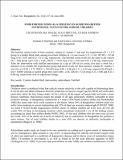Food fortification as a strategy in achieving better nutritional status of pre-school children
| dc.contributor.author | Hossain, S.M. | |
| dc.contributor.author | Malek, MA | |
| dc.contributor.author | Bhuyan, M.A.H. | |
| dc.contributor.author | Rahman, A.S.M.M. | |
| dc.contributor.author | Alamgir, L. | |
| dc.date.accessioned | 2014-04-16T20:18:06Z | |
| dc.date.available | 2014-04-16T20:18:06Z | |
| dc.date.issued | 2005-06 | |
| dc.identifier.citation | Dhaka : Asiatic society of Bangladesh, 2005 | en_US |
| dc.identifier.uri | http://hdl.handle.net/123456789/149 | |
| dc.description.abstract | The baseline serum levels of beta-carotene, vitamin E, vitamin C and zinc for experimental (N = I 17) group in a double blind study among pre-school children (4 - 6 years) were 5.11 ± 2.41, 307.69 ± 157.44 mcg, 0.16 ± 0.07 and 0.52 ± 0.11 mg, respectively. The baseline serum levels for the same in the control (N = 104) group were 5.29 ± 2.46, 330.52 ± 73.93 mcg, 0.14 ± 0.05 and 0.52 ± 0.09 mg, respectively. After the intervention with fortified antioxidants in a cup of 100 ml ice cream, five days a week for a duration of six months the experimental group had serum levels for beta-carotene, vitamin E, vitamin C and zinc as 22.64 ± 3.72, 938.27 ± 163.643 mcg, 0.96 ± 0.28 and 1.11 ± 0.14 mg, respectively (Paired t-test = 0.000) whereas n control group they were 4.80 ± 2.26, 326.50 ± 72.54 rncg, 0.15 ± 0.06 and 0.53 .t 0.09 rng, respectively with no significant change. | en_US |
| dc.language.iso | en | en_US |
| dc.publisher | Asiatic society of Bangladesh | en_US |
| dc.subject | Control | en_US |
| dc.subject | Double blind | en_US |
| dc.subject | Intervention | en_US |
| dc.subject | Antioxidants | en_US |
| dc.subject | Fortified | en_US |
| dc.title | Food fortification as a strategy in achieving better nutritional status of pre-school children | en_US |
| dc.type | Article | en_US |
الملفات في هذه المادة
هذه المادة تظهر في الحاويات التالية
-
Bangladeshi Journal [94]

